Download Vesta (Asteroid) Worksheets
Click the button below to get instant access to these premium worksheets for use in the classroom or at a home.
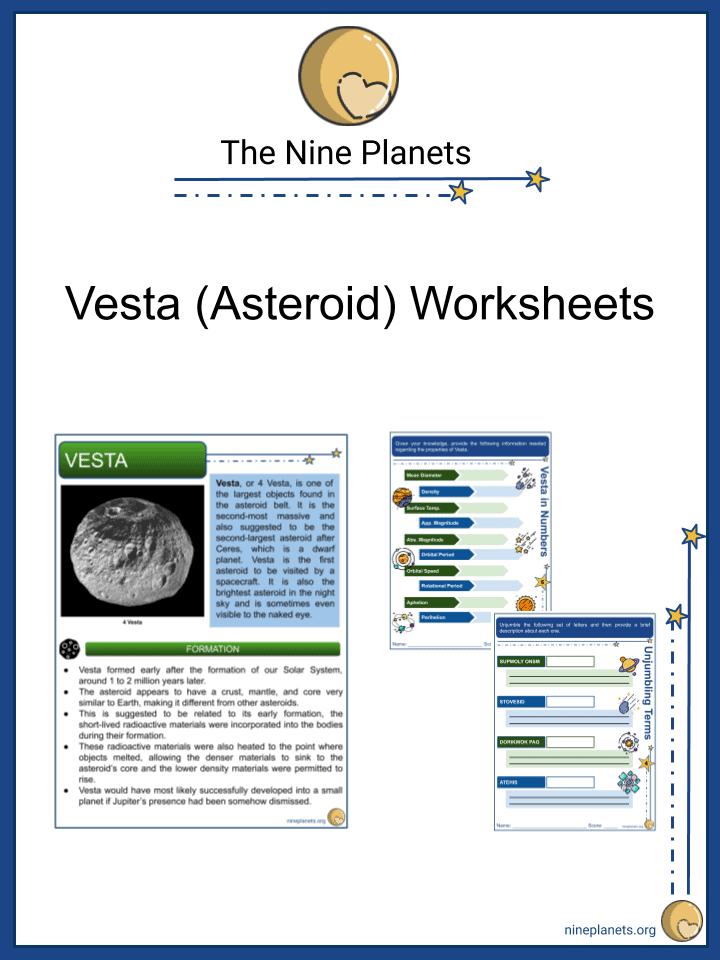
This worksheet can be edited by Premium members using the free Google Slides online software. Click the Edit button above to get started.
Download free sample
Not ready to purchase a subscription yet? Click here to download a FREE sample of this worksheet pack.
Resource Examples
Click any of the example images below to view a larger version.
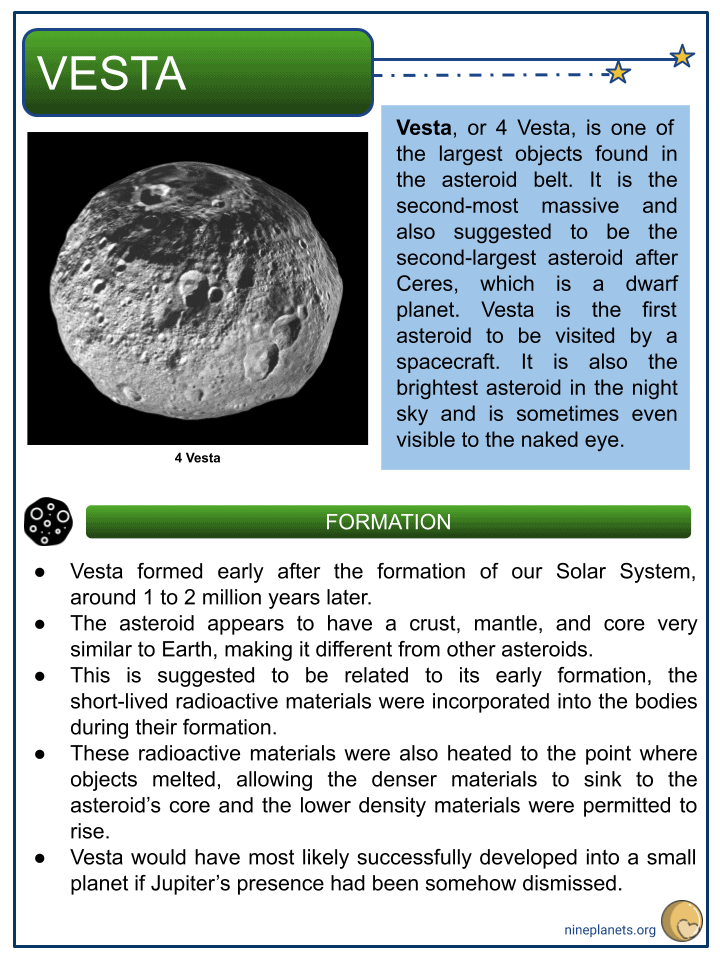
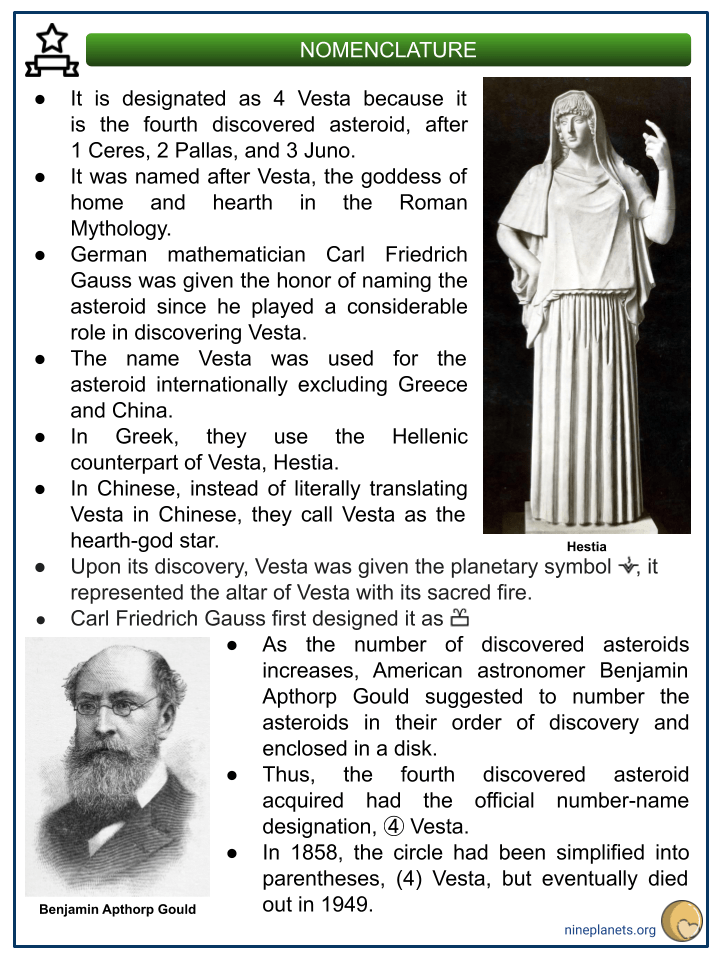
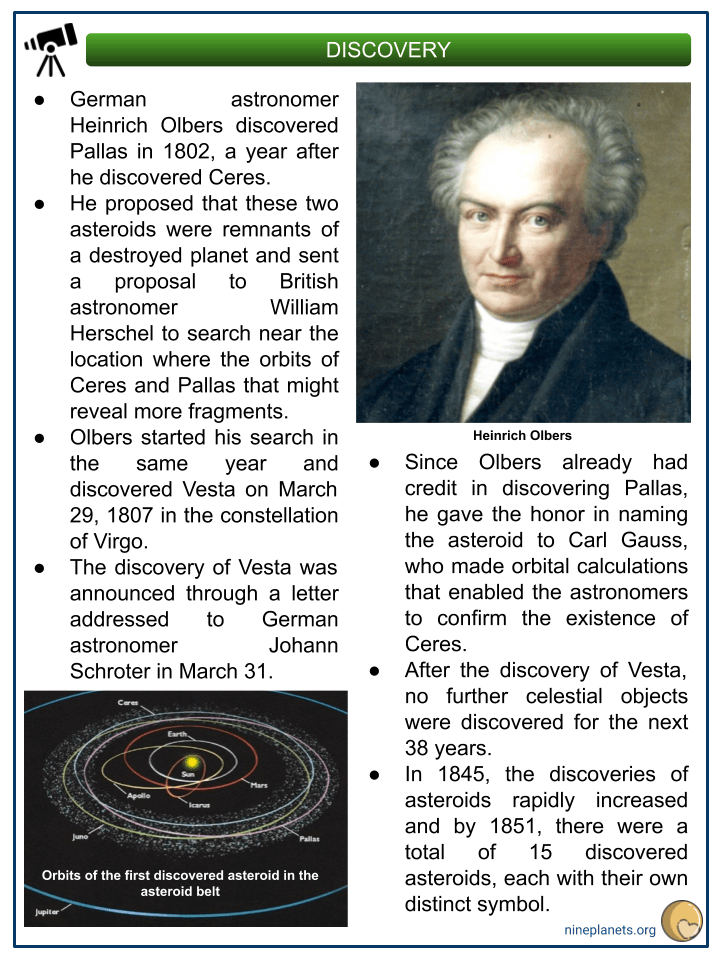
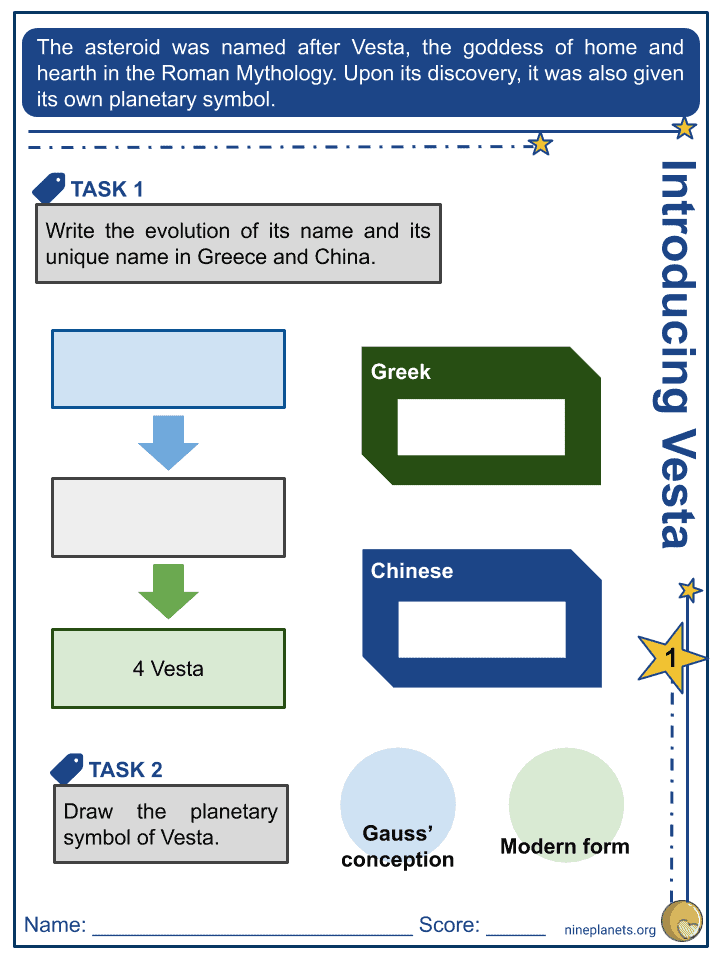
Key Facts & Information
- Vesta, or 4 Vesta, is one of the largest objects found in the asteroid belt. It is the second-most massive and also suggested to be the second-largest asteroid after Ceres, which is a dwarf planet. Vesta is the first asteroid to be visited by a spacecraft. It is also the brightest asteroid in the night sky and is sometimes even visible to the naked eye.
Formation
- Vesta formed early after the formation of our Solar System, around 1 to 2 million years later.
- The asteroid appears to have a crust, mantle, and core very similar to Earth, making it different from other asteroids.
- This is suggested to be related to its early formation, the short-lived radioactive materials were incorporated into the bodies during their formation.
- These radioactive materials were also heated to the point where objects melted, allowing the denser materials to sink to the asteroid’s core and the lower density materials were permitted to rise.
- Vesta would have most likely successfully developed into a small planet if Jupiter’s presence had been somehow dismissed.
Nomenclature
- It is designated as 4 Vesta because it is the fourth discovered asteroid, after 1 Ceres, 2 Pallas, and 3 Juno.
- It was named after Vesta, the goddess of home and hearth in the Roman Mythology.
- German mathematician Carl Friedrich Gauss was given the honor of naming the asteroid since he played a considerable role in discovering Vesta.
- The name Vesta was used for the asteroid internationally excluding Greece and China.
- In Greek, they use the Hellenic counterpart of Vesta, Hestia.
- In Chinese, instead of literally translating Vesta in Chinese, they call Vesta as the hearth-god star.
- Upon its discovery, Vesta was given the planetary symbol, it represented the altar of Vesta with its sacred fire.
- Carl Friedrich Gauss first designed it as As the number of discovered asteroids increases, American astronomer Benjamin Apthorp Gould suggested to number the asteroids in their order of discovery and enclosed in a disk.
- Thus, the fourth discovered asteroid acquired had the official number-name designation, ④ Vesta.
- In 1858, the circle had been simplified into parentheses, (4) Vesta, but eventually died out in 1949.
Discovery
- German astronomer Heinrich Olbers discovered Pallas in 1802, a year after he discovered Ceres.
- He proposed that these two asteroids were remnants of a destroyed planet and sent a proposal to British astronomer William Herschel to search near the location where the orbits of Ceres and Pallas that might reveal more fragments.
- Olbers started his search in the same year and discovered Vesta on March 29, 1807 in the constellation of Virgo.
- The discovery of Vesta was announced through a letter addressed to German astronomer Johann Schroter in March 31.
- Since Olbers already had credit in discovering Pallas, he gave the honor in naming the asteroid to Carl Gauss, who made orbital calculations that enabled the astronomers to confirm the existence of Ceres.
- After the discovery of Vesta, no further celestial objects were discovered for the next 38 years.
- In 1845, the discoveries of asteroids rapidly increased and by 1851, there were a total of 15 discovered asteroids, each with their own distinct symbol.
Properties
- Vesta is the second-most-massive body located in the asteroid belt, though it is only 28% as huge as Ceres.
- It is only slightly larger than 2 Pallas in volume, but is 25% more massive.
- It has an estimated mean diameter of around 525.5 km.
- Its density is lower than the four terrestrial planets, Mercury, Venus, Earth and Mars, but is much denser than most asteroids and all of the moons in the Solar System excluding Jupiter’s Io.
- The density of Vesta is estimated to be about 3.46 g/cm.
- Vesta has a surface area of about 800,000 square km, which is about that of Pakistan.
- Temperatures on the surface of Vesta have been estimated to be around 253 K with the sun overhead and around 83 K at the winter pole.
- Vesta is the brightest asteroid in the night sky with an apparent magnitude of 5.1 to 8.48 and an absolute magnitude of 3.20.
- The surface of Vesta is covered in bright and dark materials similar to the Moon.
- The asteroid has basaltic regions that have formed over millions of years, which indicates that lava once flowed across the surface
- Vesta’s shape is quite irregular, roughly that of an oblate spheroid.
- A gigantic crater with a diameter of 460 km has been observed on its surface.
- It cuts around 13 km into the crust which suggests that the asteroid formed during a powerful collision.
- Due to this collision, the materials ejected from Vesta became smaller Vestoids, asteroids that orbit near the Vesta, some of which crashed into our Earth as meteorites.
- There are mountain towers discovered over the southern pole of Vesta.
- Each of these are over 65,000 feet in height, almost as tall as the largest mountain/volcano in the Solar System, Olympus Mons.
- Collected data from the Dawn spacecraft revealed that liquid water once flowed on the surface of Vesta.
- Since Vesta has low temperatures and no atmosphere, the water has evaporated, but the ice may be buried under its surface.
Composition
- The interior of Vesta is quite different than most of the asteroids.
- It is very similar to that of the terrestrial planets.
- It has a crust of cooled lava covering a rocky mantle and an iron/nickel core.
- It is suggested that its core accreted within the first 10 million years after the formation of the Solar System.
- The volcanic eruptions steamed from the mantle and last for tens of hours.
- After the lava has cooled rapidly, it was buried again by more lava until the crust was finally complete.
- Its core is believed to make up around 18% of its entire mass or about two/third as massive as the Earth’s core.
- The pieces of Vesta that had fallen to Earth revealed the presence of a mineral found in lava flows, pyroxene.
- The asteroid also has a vast amount of hydrogen on its surface.
- Due to its similarity to our planet, it is suggested that Vesta holds much valuable information that could help us understand many things about Earth.
Orbit And Rotation
- Vesta orbits the Sun within the asteroid belt, between Mars and Jupiter, with an equatorial period velocity of around 93.1 m/s and a period of about 3.6 earth years.
- Vesta is specifically in the inner asteroid belt, interior at about 2.50 AU to the Kirkwood gap, a gap or dip in the distribution of the semi-major axes of the orbits of main-belt asteroids.
- It has an average orbital speed of around 19.34 km.
- The asteroid has a moderately inclined orbit of 7.1 degrees, but also an eccentricity of 0.09, similar to Mars.
- Vesta can sometimes capture some other asteroids into temporary 1:1 resonant orbital relationships for periods of up to 2 million years or more.
- As of now, there are 40 such companions that have been found.
- Vesta is also a fast spinner for an asteroid with a rotation period of around 5.34 hours.
- It has a prograde rotation and its axial tilt has been suggested to be about 29 degrees.
- At aphelion, Vesta is 2.50 AU away from the Sun while at perihelion, it is at 2.10 AU.
- Its semi-major axis is about 2.36 AU.